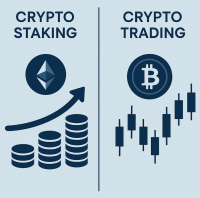Designed to overcome the limitations of earlier blockchain networks - such as scalability, governance challenges, and lack of interoperability - Polkadot has positioned itself as a foundational layer for Web3 development and cross-chain innovation.
Origins of Polkadot
Polkadot was created by Dr. Gavin Wood, one of the co-founders of Ethereum and the creator of the Solidity programming language. In 2016, Wood released the Polkadot whitepaper, outlining a vision for a scalable, interoperable, and secure network of blockchains.
To bring Polkadot to life, Wood founded the Web3 Foundation, a Swiss non-profit that funds and supports development of the decentralized web, and Parity Technologies, a software firm that develops core infrastructure for the Polkadot ecosystem.
The project launched its initial coin offering (ICO) in October 2017, raising over $140 million - one of the largest ICOs at the time. After several phases of development and testing, the Polkadot mainnet officially launched in May 2020, with DOT tokens becoming transferable in August 2020.
Usage and Ecosystem
At its core, Polkadot is a layer-0 protocol, meaning it provides the foundational architecture on which multiple blockchains (called parachains) can be built. These parachains are connected to Polkadot’s central Relay Chain, which coordinates network security, governance, and consensus.
Polkadot solves key issues that plague many existing blockchains:
- Interoperability: Polkadot enables different blockchains to communicate and exchange data without needing intermediaries.
- Scalability: By allowing multiple parachains to process transactions in parallel, Polkadot significantly increases network throughput.
- Shared Security: All parachains benefit from the security of the Relay Chain, reducing the need for individual chains to secure themselves independently.
- Customizability: Developers can create their own blockchains tailored to specific use cases while remaining interoperable with other chains.
The Polkadot ecosystem includes a growing number of parachains, many of which won their slot via parachain auctions that use crowdloans from the DOT community. Notable projects include:
- Acala – A DeFi-focused chain offering a stablecoin and liquidity solutions.
- Moonbeam – A smart contract platform that brings Ethereum compatibility to Polkadot.
- Astar Network – Focused on multi-chain dApp development and Web3 scalability.
- Phala Network – A privacy-preserving cloud computing protocol.
Beyond parachains, Polkadot also features on-chain governance, allowing DOT holders to vote on network upgrades, validator selection, and fund allocation from the on-chain treasury.
Price Milestones
Since becoming tradable in 2020, DOT has experienced significant price volatility, mirroring broader crypto market trends:
- August 2020: DOT debuted at around $2.90 after a token redenomination (100x increase in supply).
- January 2021: DOT surged past $10, riding the early 2021 bull market and anticipation for parachain launches.
- May 2021: It reached an all-time high of approximately $49.
- November 2021: DOT briefly surpassed $55, coinciding with the launch of parachain auctions and a broader market rally.
- 2022–2023: Like much of the crypto market, DOT declined during the bear cycle, falling below $5 by late 2022.
- 2024–2025: Recovery has been slow but steady. As of August 2025, DOT trades around $8.50, with renewed attention on cross-chain use cases and real-world blockchain adoption.
Price Prediction for End of 2025
Polkadot’s long-term success depends on several factors: the growth of its parachain ecosystem, developer engagement, market sentiment, and real-world adoption of Web3 applications. As more parachains become fully operational and connected, the overall utility of the DOT token is expected to increase - both as a governance asset and as collateral for staking and parachain bonding.
Other drivers for DOT’s potential price appreciation include:
- Launch of more real-world applications, especially in DeFi, gaming, and supply chain.
- Increased interoperability with Ethereum and Cosmos ecosystems.
- Strong governance model, which allows for protocol upgrades without hard forks.
- Web3 Foundation and Parity’s continued development of tooling and community resources.
Assuming continued momentum and a favorable crypto market, a moderate bullish forecast puts DOT in the $12–$18 range by December 2025. If Polkadot achieves stronger-than-expected growth - particularly with enterprise or government integrations - then a more optimistic scenario could push DOT toward the $20–$25 mark, though that would likely require a broader market rally and increased capital inflow into Layer-0 and cross-chain infrastructure projects.
Conclusion
Polkadot remains one of the most technically ambitious projects in the blockchain space, offering a unique and scalable approach to interoperability. While its price has not returned to its 2021 highs, the project’s fundamentals, active development, and expanding ecosystem suggest that it has long-term potential. For investors and developers alike, Polkadot offers a compelling vision of a multi-chain future - where blockchains don’t operate in silos, but in seamless collaboration.








